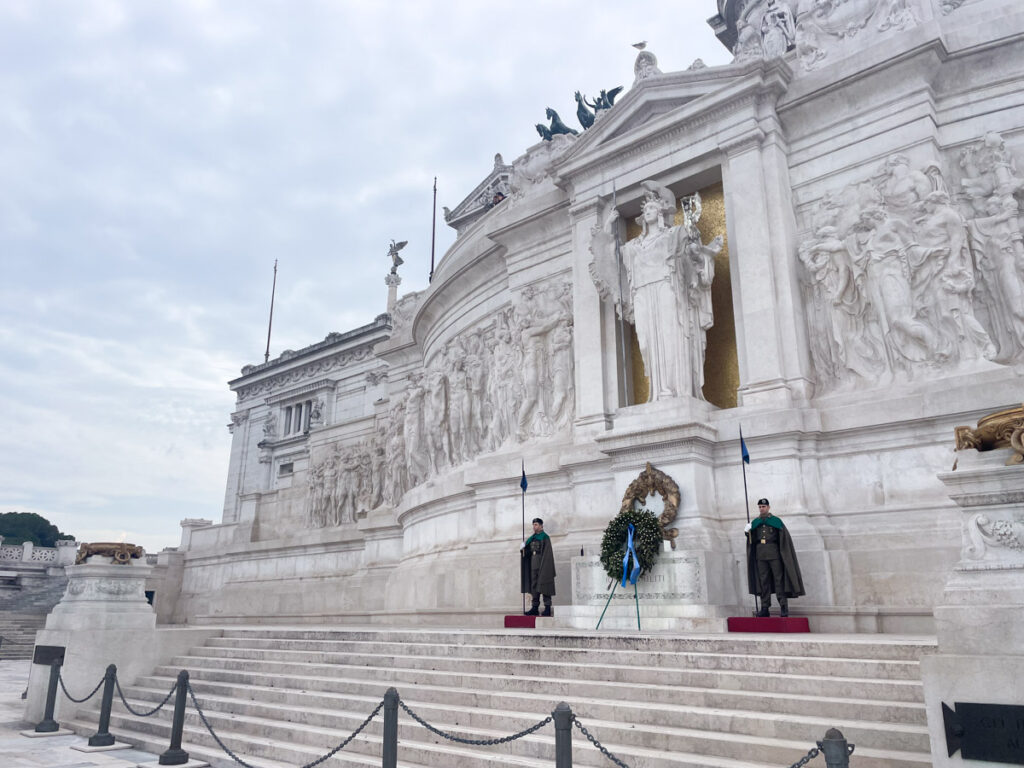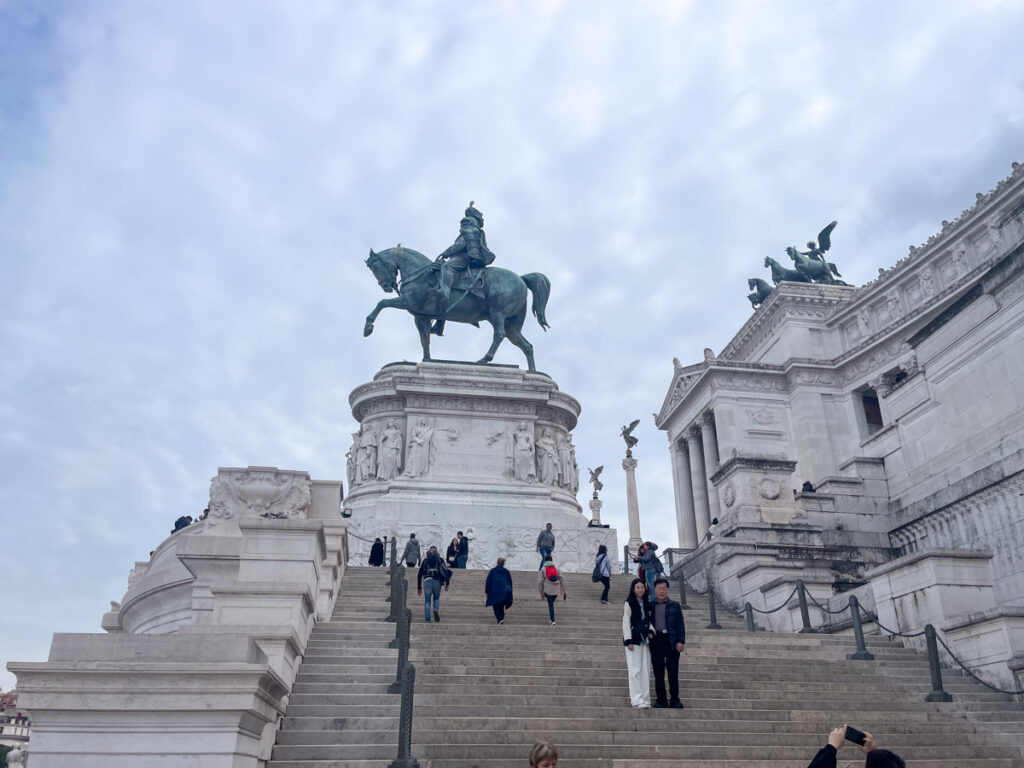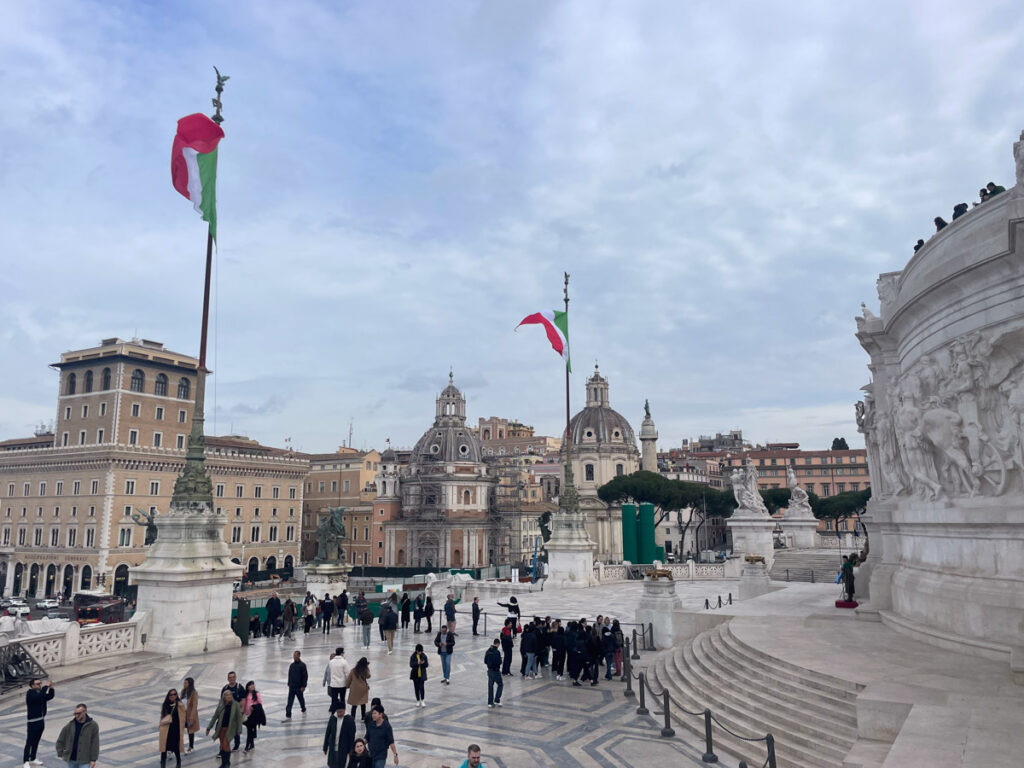The Vittoriano, also known as Victor Emmanuel II Monument or the Altare della Patria, is one of Rome’s most imposing monuments, symbolising Italian history and identity. Located between Piazza Venezia and the Campidoglio, it celebrates the Risorgimento period and honours Victor Emmanuel II as Father of the Fatherland. The structure houses the Tomb of the Unknown Soldier, called Milite Ignoto in Italian, commemorating the fallen of the First World War. The monumental complex’s impressive architecture and historical significance are essential reference points for understanding Italian culture, as you can discover by reading this article.
Table of Contents
What to see at the Victor Emmanuel II Monument in Rome
Inside the Vittoriano complex, you can see a series of monuments and places of historical and cultural interest and climb up to the panoramic terraces that offer a breathtaking view of Rome. The Vittoriano is distinguished by its imposing size and monumental structure with staircases, columns, statues and bas-reliefs.
PLAN YOUR TRIP TO ROME
Save money on entrance fees and transportation costs with the Roma Pass. This City Card offers free entry to two attractions, as well as discounts at other museums and archaeological sites, including the Colosseum, the Roman and Imperial Forums, the Capitoline Museums, the Ara Pacis and other must-see.
To stay connected in Italy, remember to buy an Airalo eSim online, with data and phone coverage for your trip to Rome.
The monumental complex, designed by architect Giuseppe Sacconi and completed in 1925, was imagined as an elevated piazza with staircases and terraces. In passing through, visitors can take a patriotic stroll among the works present, almost all of which have symbolic meanings related to the history of Italy.
The Altar of the Fatherland and the Tomb of the Unknown Soldier
The Altare della Patria (Altar of the Fatherland) is the best-known part of the Vittoriano and the one with which it is often identified, as well as the first monument you encounter when climbing the Vittoriano’s external stairs. It is the location of the Tomb of the Unknown Soldier, one of the most significant sites in the Vittoriano. This memorial houses the remains of an unknown Italian soldier who fell during the First World War.
You can see similar monuments all over Europe, such as the tomb of the Unknown Warrior at Westminster Abbey in London, or that of the Soldat Français under the Arc de Triomphe in Paris. These monuments were a way both to commemorate the sacrifice of all the soldiers who died or went missing at the front and to re-enact the collective mourning caused by the war.

The Vittoriano sculptures
The Vittoriano houses numerous sculptures, the main one being the equestrian statue of king Victor Emmanuel II, to whom the complex is dedicated. It was made by sculptors Enrico Chiaradia and Emilio Gallori in the late 19th and early 20th century, using bronze from casting some cannons of the Royal Army.
On the marble base, you can see fourteen personifications of Italian cities, regarded as the ‘noble mothers’ of Risorgimento Italy: Amalfi, Bologna, Genoa, Ferrara, Florence, Mantua, Milan, Naples, Palermo, Pisa, Ravenna, Turin, Urbino and Venice. These cities are the capitals of the states that formed Italy before Unification and in a period before the Savoy monarchy.
On the outer base of the Vittoriano, you can see the fountains of the two seas. These are two fountains, one dedicated to the Adriatic Sea and the other to the Tyrrhenian Sea, the two seas surrounding Italy. They, therefore, give the idea that the Vittoriano monumental complex represents the country.
Six other groups of statues in the Vittoriano represent allegories of the civic values of the Italian people, two in gilded bronze and four in marble. They are Action, Concord, Law, Strength, Thought and Sacrifice.

The Vittoriano museums: the Museo del Risorgimento and the Sacrario delle Bandiere
Inside the Altare della Patria, two museums tell the story of Italian history and culture: the Museo Centrale del Risorgimento Italiano and the Museo Sacrario delle Bandiere. The former traces the period of the Italian Risorgimento, exhibiting artefacts, documents and works of art that narrate national unity from the 18th century to the First World War.
The Sacrario delle Bandiere, on the other hand, exhibits the insignia of disbanded military units and radiated naval units, as well as the flags in use of the Italian Army, Air Force, Navy, Carabinieri, State Police, Prison Police and Guardia di Finanza.
The panoramic view from the Vittoriano terraces
Tourists visit the Vittoriano mainly because the terraces offer a spectacular panoramic view of the eternal city. You can admire Rome’s most famous monuments, including the Colosseum, the Pantheon and St. Peter’s Basilica, by climbing the stairs or taking the lift to the panoramic terrace.

The historical importance of the Altar of the Fatherland: national memory and Italian identity
The Vittoriano monumental complex is a symbol of the Italian identity created during the Risorgimento. However, during the fascist dictatorship, the Altare della Patria became one of the places where the regime’s events, such as military parades, were celebrated and a constant presence in propaganda films. The tomb of the Unknown Soldier itself, to which the regime often paid homage, was exploited for nationalist purposes.
With the fall of fascism, the Vittoriano lost the military content associated with it by the regime, and the Altare della Patria returned to its previous function as a symbol of national identity, hosting commemorations, celebrations and official ceremonies of the Italian Republic. These include the anniversary of the Liberation (25 April), Republic Day (2 June) and National Unity and Armed Forces Day (4 November), during which the President of the Italian Republic and the highest offices of the State pay homage to the shrine of the Unknown Soldier with the laying of a laurel wreath.
Useful tips for visiting the Vittoriano
To visit the Altar of the Fatherland, it is not necessary to plan ahead. The wide open spaces of the Victor Emmanuel II Monument prevent visitors from concentrating all in the same places, even if there are large crowds. On the contrary, to go up to the viewing terrace, I recommend buying tickets in advance online to avoid long queues both at the ticket office and at the lifts, especially during the high season when Rome is full of tourists.
To tackle the stairs and panoramic terraces, I suggest you wear comfortable clothes and shoes because the Vittoriano complex is vast and you will walk a lot. Finally, although it is full of people taking selfies in every possible pose on the steps, you should behave respectfully in front of the Tomb of the Unknown Soldier because it is a place of commemoration of the fallen.
Opening hours of the Altar of the Fatherland and museums
The Vittoriano monumental complex is open daily from 9:30 am to 7:30 pm, with the last admission at 6:45 pm. In spring and summer, the hours are usually extended until 10:30 pm. The changing of the guard at the Tomb of the Unknown Soldier takes place every hour.
How much museums and panoramic terrace tickets cost
Entrance to the Altare della Patria is free. Access by lift to the Vittoriano’s panoramic terrace and to the Museo Centrale del Risorgimento, which houses the Sacrario delle Bandiere, is charged. The ticket starts at € 17 and includes entrance to the Museo Nazionale del Palazzo di Venezia.
How to get to the Altare della Patria
The Vittoriano monumental complex, which includes the Altare della Patria, is located in Piazza Venezia, in the heart of Rome. You can easily reach it by public transport or on foot from major tourist attractions such as the Colosseum or the Trevi Fountain.
Vittoriano (Altar of the Fatherland)
Piazza Venezia, 00186 Rome
Where to stay in Rome
I have tried several hotels in Rome during my travels and I recommend staying in the city centre to avoid the chaotic traffic of the capital. Among the hotels I suggest, the charming Roma Suites Navona has family rooms and is in a great location just a few steps from Piazza Navona.
If you prefer a hotel with a buffet breakfast, you can choose the Bloom Hotel Rome, very close to St Peter’s Basilica, while if you arrive by train, the best choice near Termini station is the DoubleTree By Hilton Rome Monti hotel with double and family rooms.
Visiting the Altare della Patria (Altar of the Fatherland) and the Vittoriano is an experience that goes beyond a simple sightseeing tour because it tells the story of Italy’s Risorgimento and is still the place where the main ceremonies of the Italian Republic take place. From its imposing architecture to its panoramic view of the Eternal City, the Victor Emmanuel II Monument embodies the very essence of Rome and the entire Italian nation. Share in the comments if you already knew the Vittoriano or if you decided to visit it after reading this article.
